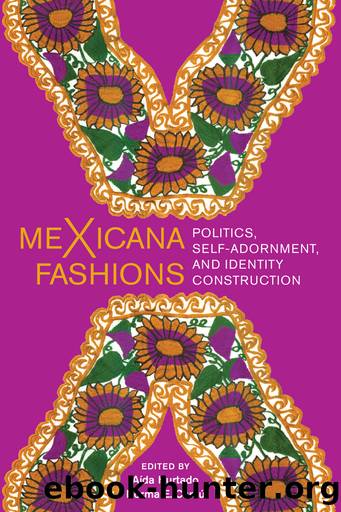meXicana Fashions by Aída Hurtado

Author:Aída Hurtado [Hurtado, Aída]
Language: eng
Format: epub
Publisher: University of Texas Press
Published: 2019-06-15T00:00:00+00:00
Another mechanism used to center whiteness is the composition of the photo image placed on the magazine cover. Covers are the most immediately visible component of the magazine, seen even by non-readers who encounter womenâs magazines in their day-to-day life and who process the cover image without exposure to the inner content. Also, it is the issueâs cover that is archived, posted on the internet, and generally discussed in much of the research (table 7.3). On the covers of the seventeen issues under review, not a single one contained a person of Color. The covers exalt and reinforce the privileged (and desirable) position of white, visually heterosexual femininities (with one exception, in which the cover space is shared with white men).
Framing Difference: Cultural Appropriation to Center Whiteness
In August 2007, Vogue España created an extensive multipage layout entitled âBuscando a Frida,â with the following caption:
Volantes, estampados y plataformas se dan cita con el foclore y el colorido mexicanos. La moda rinde tributo a Frida Kahlo en el año de su centenario y Vogue lo recuerda a ritmo de ranchera. Fotos: Anne Menecke.
[Frills, prints and platforms are brought together with the colorfulness in Mexican folklore. Fashion pays tribute to Frida Kahlo on the occasion of the 100th year of her birth and Vogue remembers her to the rhythm of Mexican ranchera (folk music).]
The feature spread runs over sixteen pages (112â127), the most extensive depiction of an explicitly ethnicized female figure in the seventeen issues reviewed. The model who portrays Frida has dark hair but otherwise displays European facial features, including green eyes; she was reliably judged as white by three coders. The âFridaâ model is shown in various settings located in an unidentified, possibly Mexican beachfront pueblo (although it could be in any country). The model wears updated, very expensive versions of the Frida aesthetic, characterized by large ethnic jewelry, bright colors usually associated with a Mexican peasant aesthetic, skirts and blouses with large ruffles, and other elements of Indigenous clothing. Several of the photographs include âlocalsâ within the display. In one depiction, Frida plays loterÃa with an elderly man dressed in a straw hat and an Indigenous shirt, sporting a disheveled beard. In several other depictions, Frida is captured in various group shots: she is the center of attention and is surrounded by âsavagery.â In one instance, the display is entitled âViva Zapata,â with no further explanation of the historical and political significance of this Mexican revolutionary figure. Encircling the model are children carrying fake rifles and wearing âcostumesâ of Indigenous peasantry and painted-on mustaches and goatees. While the Frida model is wearing an outfit that costs 2,668 euros, the children wear straw sombreros, wave small Mexican flags, and stand before a beat-up Volkswagen on a dirt road. In another instance, Frida is at an outdoor fiesta (dressed in an Oscar de La Renta priced at 4,610 euros, not counting accessories, which add up to an additional 2,435 euros) dancing with a young girl in peasant clothing. The depiction is entitled âFiesta Mariachi.
Download
This site does not store any files on its server. We only index and link to content provided by other sites. Please contact the content providers to delete copyright contents if any and email us, we'll remove relevant links or contents immediately.
Cecilia; Or, Memoirs of an Heiress — Volume 1 by Fanny Burney(32440)
Cecilia; Or, Memoirs of an Heiress — Volume 2 by Fanny Burney(31875)
Cecilia; Or, Memoirs of an Heiress — Volume 3 by Fanny Burney(31858)
The Great Music City by Andrea Baker(31539)
We're Going to Need More Wine by Gabrielle Union(18973)
All the Missing Girls by Megan Miranda(15599)
Pimp by Iceberg Slim(14399)
Bombshells: Glamour Girls of a Lifetime by Sullivan Steve(13979)
Talking to Strangers by Malcolm Gladwell(13233)
Norse Mythology by Gaiman Neil(13217)
Fifty Shades Freed by E L James(13163)
For the Love of Europe by Rick Steves(13128)
Mindhunter: Inside the FBI's Elite Serial Crime Unit by John E. Douglas & Mark Olshaker(9212)
Crazy Rich Asians by Kevin Kwan(9174)
The Lost Art of Listening by Michael P. Nichols(7412)
Enlightenment Now: The Case for Reason, Science, Humanism, and Progress by Steven Pinker(7242)
The Four Agreements by Don Miguel Ruiz(6641)
Bad Blood by John Carreyrou(6559)
Weapons of Math Destruction by Cathy O'Neil(6152)
